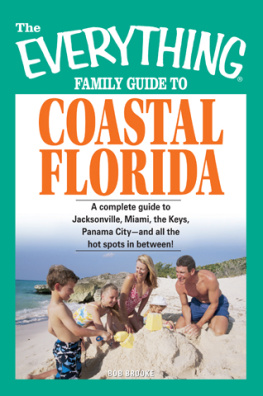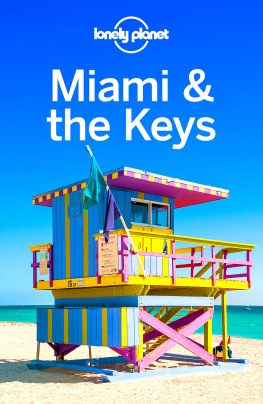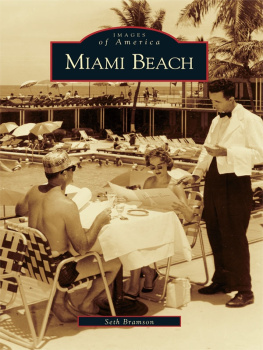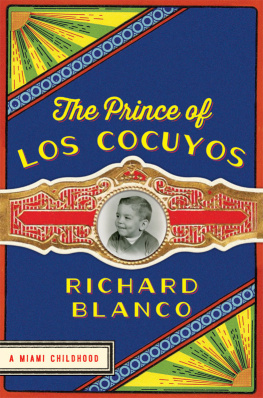CHAPTER I. PERSPECTIVE OF THE CITY OF MIAMI IN 1896
THE city of Miami, at this writing, is twenty-nine years old and has a permanent population of approximately seventy-five thousand. Its general aspect is that of a city of the one-hundred-thousand class. Of the recent settlers none but those of the most vivid imagination could form a true conception of the process of its growth and successive stages of its development.
The story of Miami, as related in these pages, is a record of the city's progress; the vicissitudes of its pioneers, their activities, foibles, contentions, ideals and aspirations. This narrative will commence with the city's topographical aspect.
Commencing at the north-shore line of the Miami River, at the foot of Avenue "D" (South Miami Avenue), and terminating at the intersection of First Street (North Eleventh Street), the writer recalls the following structures: Captain Vail's steamboat hotel; the late Adam Correll's livery stable; a row of stores and a two-story hotel building on the east side of Avenue "D." These were occupied by Lummus Brothers, Frank T. Budge, the late S. A. Belcher, C. H. Raullerson and Salem Graham's baker shop. (The town had originally adopted the following street-naming system; commencing at the northern boundary line, at the intersection of North Miami Avenue and Eleventh Street, running in a southerly direction, the streets running east and west received consecutive numerical designations. Commencing at the west-shore line of Biscayne Bay, the thoroughfares running north and south, excepting the thoroughfare fronting on the bay which was named "The Boulevard," were designated alphabetically as avenues. This system was in force during the first twenty-four years of Miami's existence.) Across the street from the above-mentioned structures stood the home of Miami's first newspaper, the Miami Metropolis, and a huge tent in which religious services and community meetings were held. The storerooms in the south end of the hotel structure were occupied by Townley Brothers, Sewell Brothers and the late Dr. J. M. Jackson, Jr.
At the corner of the next block, on the east side of the avenue, stood E. L. Brady's building. East of the latter, fronting on Fourteenth Street (Southeast Second Street), stood the Bank of Bay Biscayne and John W. Watson's building. On the west side of the avenue stood the late Captain Chase's building. West of the latter, fronting on Fourteenth Street, there were several buildings housing various lines of business. The completion of the foregoing structures was followed by the erection of a number of buildings on both sides of the avenue, terminating at the corner of Thirteenth Street. These were occupied by operators of restaurants, cold-drink parlors, dry-goods, clothing and shoe stores, butcher shop, hardware store and racket store (the harbinger of the present-day five- and ten-cents stores). The latter were followed by two attractive two-story brick-veneer buildings and a three-story solid brick structure. The former at each end of the block on the west side of Avenue "D" (South Miami Avenue), between Twelfth and Thirteenth streets (Flagler and South First streets), and the latter on the southeast corner of Twelfth Street and Avenue "D" (Flagler Street and Miami Avenue). These are the oldest business buildings extant.
At the northeast corner of Avenue "D" and Eleventh Street (North Miami Avenue and First Street) stood a large frame structure, in which the biggest dry-goods store of that period was operated by a firm named Lovette & Laws. At the corner across the street from the latter stood a two-story frame building, the ground floor of which was occupied by the late T. N. Gautier as a grocery store, and the upper story housed Mrs. Gautier's boarding house. Toward the west from the latter, fronting south on Eleventh Street, there stood a frame building which housed the late Edwin Nelson's undertaking and furniture establishment. There were also several shacks along both sides of the railroad tracks, between Eleventh and Fourteenth streets, in one of which the city hall and jail were located.
East of Avenue " D " on Thirteenth and Fourteenth streets, several attractive two-story cottages were built by the late Henry M. Flagler, some of which are still in existence but have long since passed out of the latter's ownership. Similar cottages were erected on Avenue "B" between Twelfth and Fourteenth streets (Southeast Second Avenue, between Flagler and Second streets). A number of other buildings were started in every direction, but the town had not as yet emerged from the plank sidewalk stage of its development. In the beginning of the month of December, several of the leading firms had removed to Twelfth Street (Flagler Street), which thoroughfare soon superseded Avenue "D" (Miami Avenue) as the main business street.
At the beginning of that year there was a little business and residential center on the south side of the river, at a point close to the approach of the Southwest Second Avenue bridge (formerly Avenue "G"), in addition to a similar center at Brickeirs Point, where the post-office was located. (The late Alice Brickell was postmistress. She was succeeded by Joseph S. Warner, H. C. Budge, Morgan E. Jones, F. M. Brown, A. E. Cully (acting) and the present incumbent, John D. Gardner.)
During that period and for a number of years thereafter, the territory beyond the north line of the city limits (at the intersection of North Miami Avenue and Eleventh Street) harbored a number of saloons, gambling houses and kindred evils. Numerous murders and other outrages were committed in that erstwhile notorious locality. That former unsavory district, which was known as "North Miami," flourished until about fifteen years ago, when Dan Hardie, upon having been elected sheriff of Dade County, had fulfilled his preelection promises in driving its denizens into the northwestern section of the city adjoining colored town. That new segregated district became known as "Hardieville." After years of protest by the decent element of the colored population the neighborhood was finally purged of its incubus.
As the year advanced new settlers arrived on every train, and the town expanded in every direction. The majority of Miami's population of the first year came from West Palm Beach, Titusville and Kissimmee. In spite of the countless buildings that were hastily erected, numerous families had been obliged to live in tents. At this stage of Miami's development, the Flagler and Tuttle land agents vigorously pushed the sale of building lots, offering special inducements to those who possessed enough funds to make small payments on same. Flagler Street corner lots sold at $900, and inside ones at $800 (50 x 150). Miami Avenue lots sold at $300 to $400 each, and West Flagler Street, between the railroad tracks and the river, at $300 to #400. First and Second Avenue lots sold at about the same prices. Little attention was paid to bay-front property, owing to its seeming great distance from the center of the city, although that locality possessed the attractive features of water frontage, and a potential park along the shore between Seventh and Twelfth streets (Fifth and Flagler streets).
Before the year passed parts of the Boulevard (North Bayshore Drive), Flagler Street, Second, First and Miami avenues were paved with native rock (the same material that entered into the construction of the present courthouse, city hall and Halcyon hotel), and the town assumed the appearance of a modern little city. This improvement, however, had caused insufferable annoyance to the inhabitants who were obliged to shield their eyes with colored spectacles from the glaring whiteness of the streets. In the course of time repeated attempts to eradicate that nuisance were made, in which a liquid known as "Tarvia" was employed, all of which proved abortive. However, the sensitive eyes of the pioneers finally became adapted to this irritation and no permanent harm resulted therefrom.










